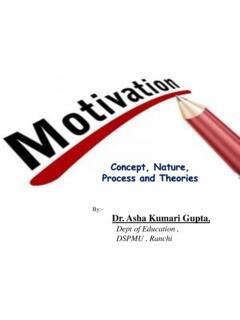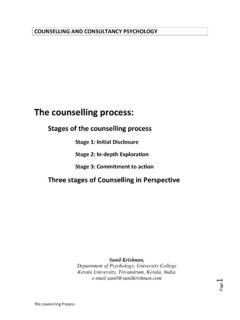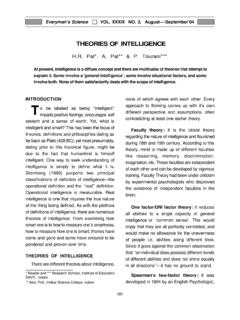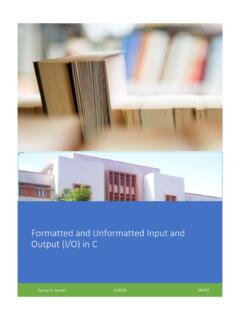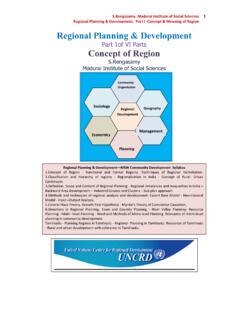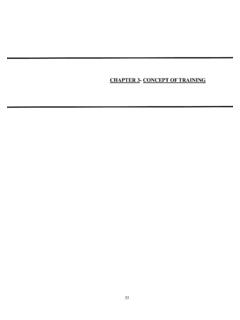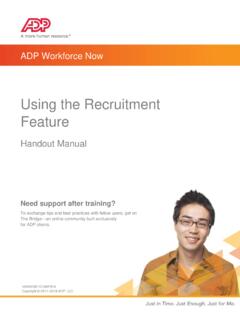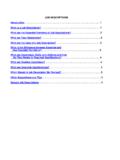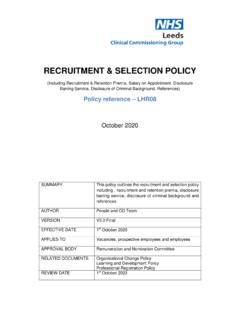Transcription of CHAPTER - IV RECRUITMENT AND SELECTION PROCESS
1 Page 118 CHAPTER - IV RECRUITMENT AND SELECTION PROCESS This CHAPTER deals with the RECRUITMENT and SELECTION PROCESS of small and medium scale industries providing the all-important information related RECRUITMENT and SELECTION . RECRUITMENT and SELECTION constitutes a staffing function of management. Scientific SELECTION ensures right man for the right job. For creating a team of efficient, capable and loyal employees, proper attention needs to be given to scientific SELECTION of managers and other employees. The conventional approach of selecting managers in a casual manner is now treated as outdated and is being replaced by scientific and rational approach, deciding who should hire under the employment rule of the organisation for the short and long-term interests of the individual employee and the RECRUITMENT and SELECTION is the PROCESS of getting human resources into organizations, departments, sections and jobs use.
2 What might be an even more useful definition of RECRUITMENT is that about the art of discovering and procuring potential applicants for actual and anticipated vacancies in the organization. This definition has introduced the concept of art which is about the soft skills of management, some of which might be a natural talent of some managers or acquired through specialized training. The use of the word discover emphasizes effective RECRUITMENT , a PROCESS that involves exploration which require specialized methods and techniques, short of which no discovery of potential people for the job can be made. Usually, RECRUITMENT and SELECTION depends on the organization s policy guiding RECRUITMENT and Page 119 basic principle in SELECTION is "right man for the right job" and can be achieved only through scientific RECRUITMENT and SELECTION .
3 This is because the ability of an organization is determined to a great extent by the ability of its workforce. The old belief that capital was fundamental to the progress of the organisation and does not hold good any longer as employers around the world have begun to believe that a smart workforce is the key to the success of an RECRUITMENT : RECRUITMENT means an activity which refers to the discovery and development of workers and employees in the enterprise at the time they are required. It involves locating, maintaining and contacting the sources of man power. The RECRUITMENT has been defined by many eminent authors as under: In the words of Flippo, RECRUITMENT is the PROCESS of searching for prospective employees and stimulating and encouraging them to apply for jobs in the organisation.
4 3 According to Dale Yoder, RECRUITMENT is a PROCESS to discover the sources of manpower to meet the requirement of the staffing schedule and to employ effective measures for attracting that manpower in adequate numbers to facilitate effective SELECTION of an efficient working force. 4 In short RECRUITMENT is the PROCESS of searching for prospective employees and stimulating them for jobs in the organisation, Thus, the RECRUITMENT of employees involves the identification of the sources of personnel, evaluation of different sources available, SELECTION of a particular source and stimulating the prospective candidates to apply for the job so that right candidates may be obtained for right job. Page 120 RECRUITMENT PROCESS : The RECRUITMENT and SELECTION is the major function of the human resource department.
5 RECRUITMENT PROCESS is the first step towards creating the competitive strength and the strategic advantage for the organizations. In an ideal RECRUITMENT programme, individuals responsible for the RECRUITMENT PROCESS must know how many and what types of employees are needed, where and how to look for individuals with the appropriate qualification and interests, what inducements to use or to avoid for various types of applicant groups, how to distinguish applicants who are unqualified from those who have a reasonable chance of success and how to evaluate their PROCESS involves a systematic procedure from sourcing the candidates to arranging and conducting the interviews and requires many resources and time.
6 A general RECRUITMENT PROCESS is as follows: Graph No. : shows the PROCESS of RECRUITMENT A RECRUITMENT policyA RECRUITMENT organisationDevelopment of sources of recruitmentTechnique used to tap there sourcesA method of assesing the recuitment programme Page 121 Characteristics of a Good RECRUITMENT Policy: A good RECRUITMENT policy is the guiding can save an organization from facing situations like unproductive test and interview due to non-availability of the right candidate in the applicant pool, compromising on the SELECTION of good candidates, high attrition rate low productivity and low motivation among existing employees as a result of faulty success of an enterprise largely depends upon the ability and efficiency of its employees.
7 To get the capable and efficient employees, the RECRUITMENT policy of the organization must be very sound. An ideal RECRUITMENT policy must have following characteristics: 1. All selections must be made at a central place of the enterprise. 2. The whole PROCESS of RECRUITMENT must be strictly in accordance with the merit. 3. The number of employees to be recruited must be determined well in advance according to the need of enterprise. 4. No such assurance should be given at the time of RECRUITMENT which may not be followed later on. 5. Higher posts must be filled up through promotions, so far as possible. 6. The qualification experience, terms of service, salaries etc. must be determined well in advance. 7. The SELECTION of employees must be accordance with the merit.
8 8. The abilities of employees must be according to the need of their jobs. 9. New posts must be authorized by a higher officer. 10. RECRUITMENT policy must be fair and flexible. Page 122 RECRUITMENT PRACTICES IN INDIA: Since 1991, the business environment in India has been dynamic and continuously changing. Business organizations have been growing at very rapid pace and globalizing. Consequently, organizations are now looking for globally competitive workforce. These changing expectations and requirements have compelled the Indian industrial management to introduce changes in every sphere of human resource activity, including RECRUITMENT and The features of RECRUITMENT in India are the following: 1. Our industrial labour force consists almost entirely of persons with littleexperience or no experience of industrial life and work.
9 They keep still strong influences the tradition and values of their rural or pre-industrial background. Often the new recruits to the industrial labour force have great difficulty in adjusting themselves to the rhythm, discipline and social relationships in the industrial undertaking, and to the new way of life in the community of which the undertaking forms a part. Their acceptance of the new environment proceeds at a slow pace, and this is often expressed through absenteeism, high labour turnover stoppages of work and other facts of protest. Such factors generally become more important when more advanced technology is introduced and new problem of manpower replacement are created by the higher skills required.
10 2. There is a great disproportion between the number of positions available and the number of aspirants. Sometimes, the ratio is in as much as 1:100 or even more. Not only is the expenditure and inconvenience involved in examining a large number of candidates Page 123 for a few positions great, but also the spectacle of so many persons making applications and getting disappointed is a dismal one. Furthermore, the large number of applications that need to be processed and the equally large number of candidates who need to be examined and evaluated is an important source of delays. On account of the present conditions of acute unemployment the chances of incorrect matching of the job and the individual are higher here than in the developed western countries.
